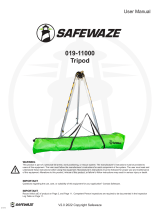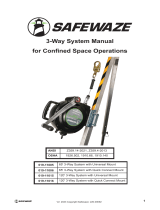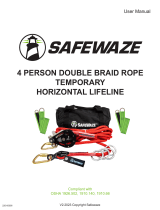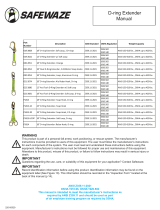Page is loading ...

USER INSTRUCTION MANUAL
WINCH
PERSONNEL
019-11007 - 65' Personnel Winch
019-11008 - 115' Personnel Winch
This instruction manual
applies to the following models:
220-00024

225 Wilshire Ave SW, Concord, NC 28025 (800) 230-0319
www.safewaze.com
1
This manual is intended to meet industry standards, including OSHA and ANSI and should be used as part of an employee training
program as required by OSHA.
Warning : This product is to be used as part of a complete system. The user must follow the manufacturer's instructions for each
component of the complete system. These instructions must be provided to the user of this equipment. Manufacturer's
instructions must be followed for proper use and maintenance of this product. Alterations or misuse of this product, or failure to
follow instructions may result in serious injury or death.
Important : Before using this equipment record the product identification information from the label on the winch in the inspection and
maintenance log of this manual. The 019-11007, 019-11008 Safewaze Manually Operated Winches are classified by Underwriters
Laboratories, Inc. as to the 300 lbs. load capacity only.
1. DESCRIPTION:
Safewaze Winches:
� 019-11007, 019-11008: Comes with Galvanized Steel wire rope of dia 1/4''
Note: 019-11007, 019-11008 comes with a INDEPENDENT REEL MODE for quick and easy installation of the Winch
2. APPLICATIONS :
Purpose : Safewaze winches are to be used for personnel riding, material handling or rescue and evacuation. These winch models
are to be used with a Tripod, or other support structure, and may be used in situations where personnel or materials need to be
raised or lowered 50ft -130ft with 019-11007, 019-11008.
Winch Application Types :
Personnel Riding : The Safewaze winch is used to raise or lower a worker to a work level. At the work level the worker is no
longer supported by the winch. It is recommended that the worker be connected to a back-up arrest system while being
raised or lowered.
Rescue and Evacuation : The Safewaze winch is used to raise or lower an endangered or injured worker, or rescue
personnel. Applications include permit and non-permit confined space entry work.
� Limitations: The following application limitations must be considered before using this product. Failure to observe product
limitations could result in serious injury or death.
�Installation : The winch must be installed in accordance with the requirements stated in this manual.
� Capacity : The maximum working load for this product is 300 lbs. (135 kg).
� Personal Fall Arrest Systems : Personal fall arrest systems used with the Safewaze winch must meet applicable state and
federal regulations.
� Physical and Environmental Hazards : Use of this equipment in areas with physical or environmental hazards may
�
�
�
�
Do not skip this instruction manual. Read the instruction manual carefully before using the equipment. If failed in
doing so it may cause serious injury or Death.
This manual must be read and understood in its entirety and used as part of fall protection training program as required by
OSHA or any state regularity agency. These instructions are intended to meet the manufacturer instructions as required by
The user must fully understand the proper use of this equipment and its limitations.
ANSI Z117.1-2016, Z359.4-2013, A10.32-2012, OSHA 1926.502, 1910.140, 1926.21.
These Instructions apply to the following Models:
019-11007, 019-11008
NOTE: The User is advised to keep the user instructions documents for the life of the product.

2
require additional precautions to reduce the possibility of damage to this equipment or injury to the user. Hazards may
include, but are not limited to; high heat (welding or metal cutting), acidic or caustic chemicals, corrosive environments
such as exposure to seawater, high voltage power lines, explosive or toxic gases, moving machinery or sharp edges.
Contact Safewaze if you have questions about the application of this equipment in areas where physical or environmental
hazards are present.
Training: This equipment is to be installed and used by persons who have been trained in its correct application and use.
� Refer to national standards, including; ANSI, local, state, and OSHA requirements for more information on the application of this
and associated equipment.
3.0 SYSTEM REQUIREMENTS :
� Compatibility of Components : Safewaze equipment is designed for use with Safewaze approved components and subsystems
only. Substitutions or replacements made with nonapproved components or subsystems may jeopardize compatibility of
equipment and may effect the safety and reliability of the complete system.
�Compatibility of Connectors : Connectors are considered to be compatible with connecting elements when they have been
designed to work together in such a way that their sizes and shapes do not cause their gate mechanisms to inadvertently open
regardless of how they become oriented. Contact Safewaze if you have any questions about compatibility.
Connectors (Hooks, Karabiners, and D-rings) must be capable of supporting at least 5,000 lbs. (23kN). Connectors must be
compatible with the anchorage or other system components. Do not use equipment that is not compatible. Non-compatible
connectors may unintentionally disengage. Connectors must be compatible in size, shape, and strength. Self locking snap
hooks and karabiners are required by ANSI Z359.12 and OSHA.
� Making Connections : Only use self-locking snap hooks and karabiners with this equipment. Only use connectors that are
suitable to each application. Ensure all connections are compatible in size, shape and strength. Do not use equipment that is not
compatible. Ensure all connectors are fully closed and locked:
To a D-ring to which another connector is attached.
�
�
In a manner that would result in a load on the gate.
Note : Large throat opening snap hooks should not be connected to standard size D-rings or similar objects which results in a
load on the gate if the hook or D-ring twists or rotates. Large throat snap hooks are designed for use on fixed structural elements
such as rebar or cross members that are not shaped in a way that can capture the gate of the hook.
�In a false engagement, where features that protrude from the snap hook or carabiner catch on the anchor and without visual
confirmation seems to be fully engaged to the anchor point.
�To each other.
�Directly to webbing or rope lanyard or tie-back (unless the manufacturer's instructions for both the lanyard and connector
specifically allows such a connection).
�Unintentional Disengagement (Roll-out) :
If the connecting element, that a snap hook (shown) or carabiner attaches to, is undersized or irregular in shape, a situation could occur
where the connecting element applies a force to the gate of the snap hook or carabiner. This force may cause the gate (of either a self-
locking or a non-locking snap hook) to open, allowing the snap hook or carabiner to disengage from the connecting point.
To any object which is shaped or dimensioned such that the snap hook or carabiner will not close and lock, or that roll-out could
occur.
4.0 OPERATION AND USE :
Warning : Do not alter or intentionally misuse this equipment. Consult Safewaze when using this equipment in combination with
components or subsystems other than those described in this manual. Some subsystem and component combinations may
interfere with the operation of this equipment. Use caution when using this equipment around moving machinery, electrical
hazards, chemical hazards, and sharp edges.
Warning : Consult your doctor if there is reason to doubt your fitness to safely absorb the shock from a fall arrest. Age and fitness
seriously affect a worker's ability to withstand falls. Pregnant women or minors must not use a Safewaze winch, unless for
unavoidable emergency use situations.
Before each use : Before each use of this equipment carefully inspect it to ensure it is in good working condition. Check
for worn or damaged parts. Ensure all parts are present and secure. Check operation of winch; ensure that it will lift, lower,
and hold the load under normal operation. Check winch and entire system for damage and corrosion. Do not use if
inspection reveals an unsafe condition.
�
�

3
�Inappropriate Connections : Plan your system and how it will function before starting your work. Consider all factors that affect
your safety during use. Some important points to consider when planning your system are:
� Hazard Evaluation : Evaluate job site hazards prior to starting work. Consult applicable OSHA and industry standards for
guidelines and regulatory requirements on issues such as confined space entry, personal fall arrest systems (PFAS), and
single point adjustable suspended scaffolds.
� Work Site Geometry : The installation and use of the support structure (Tripod, davit arm and base) must be consistent
with the geometric requirements stated in the associated manufacturer's instruction manuals. When suspending working
lines from the support structure, check for obstructions or sharp edges in the work path. Avoid working where the user
may swing and hit an object, or where lines may cross or tangle with that of another worker.
� Secondary or back-up Fall Arrest System : When using the winch as a support for work positioning, a secondary or
back-up fall arrest system is required. The Safewaze Tripod/K-Pod has provisions for connection of a secondary or
back-up PFAS.
� Rescue : A means of dealing with an accident or emergency must be planned in advance. Response time can play an
important role in the survival of an injured worker. Users of this equipment must be trained in emergency procedures.
� Requirements for personal Fall Arrest Systems : PFAS used with the Safewaze winch and support structure must meet
applicable OSHA requirements. The PFAS should be rigged to minimize any potential free fall and never allow a free fall greater
than 6 feet. It is recommended that the PFAS used with this equipment include a full body harness as the body support
component. PFAS's that incorporate full body harnesses must maintain fall arrest forces below 1,800 lbs. and arrest the fall
within 42 inches. Body belts, unless incorporated into a full body harness, are not recommended for use with this equipment. A
typical PFAS includes a full body harness, connecting subsystem or component (self retracting lifeline or lifeline and rope grab),
and the necessary connectors to couple the system together. Anchorages selected for PFAS must sustain static loads, applied
in the directions permitted by the PFAS, of at least; (A) 3,600 lbs. (16kN) when certification exists (see ANSI Z359.1 for
certification definition), or (B) 5,000 lbs. (23kN) in the absence of certification. When more than one PFAS is attached to an
anchorage, the anchorage strengths set forth in (A) and (B) must be multiplied by the number of PFAS attached to the anchorage.
Per OSHA 1926.500 and 1910.66: Anchorages used for attachment of a PFAS shall be independent of any anchorage being
used to support or suspend platforms, and must support at least 5,000 lbs. (23kN) per user attached, or be designed, installed,
and used as part of a complete PFAS which maintains a safety factor of at least two, and is supervised by a qualified person.
Warning: Read and follow manufacturer's instructions for the personal fall arrest equipment selected for use with the winch and
support structure.
Important : Body belts are not a llowed for free fall situations. Body belts increase the risk of injury during fall arrest in comparison to a full
body harness. Limited suspension time and the potential for improperly wearing a body belt may result in added danger to the user's health.
STEP 1
Winch Tripod
Leg
Fixture
Plate
STEP 2
Seat Winch
Plate
on Tripod
Bracket
STEP 3
Insert
Locking
Pin
STEP 1: Place the winch on the pre - installed fixture plate of the Tripod.
STEP 2: Seat the hook of the winch bracket plate onto the cross bar of the Tripod Bracket.
STEP 3: Insert the Locking Pin into the pre-drilled holes in the winch bracket plate and Tripod Bracket.
5. INSTALLATION STEPS FOR WINCH 019-11007, 019-11008:

6. TRAINING :
� It is the responsibility of the user to ensure they are familiar with these instructions, and are trained in the correct care and use of
this equipment.
7. INSPECTION :
� Frequency :
�Before each use : Visually inspect the Winch for proper functioning.
�Monthly : A formal inspection of the winch should be done by a competent person other than the user. Record results in
the equipment record table.
�Annual: It is recommended that the winch be serviced by a factory authorized service center or the manufacturer. Extreme
working conditions may require increasing the frequency of inspections. Annual servicing shall include, but not be limited
to, an intensive inspection and cleaning of all internal and external components. Failure to provide proper service may
shorten product life and could endanger performance.
After an impact: Inspect entire winch.
Warning : If the winch has been subjected to impact forces, it must be immediately removed from service and inspected. If the winch fails to
pass the inspection, do not use. The equipment must be sent to an authorized service center for repair.
Important : Extreme working conditions (harsh environment, prolonged use, etc.) may require increasing the frequency of inspections.
8. MAINTENANCE, SERVICING & STORAGE :
� Periodically clean the exterior of the winch using water and a mild detergent solution. Clean labels as required. At least twice a
year, clean and lubricate the wire rope. Do not use solvents to clean the wire rope as they will remove internal lubrication.
Lubricate wire rope using a cloth (wearing gloves) and a light machine oil.
Rated Working Load 310 lbs.
Wire Rope Type 1/4 inch diameter, 7x19 galvanized Steel.
4
STEP 5 STEP 6STEP 4
A
n
t
i
-
C
l
o
c
k
w
i
s
e
A
n
t
i
-
C
l
o
c
k
w
i
s
e
STEP 4: Pull out the handle of the winch outside and rotate it anti-clock wise to release the steel wire. Keep on releasing till you are
able to release enough length such that it can pass over the pulleys of the Tripod and get suspended vertically
downwards.
STEP 5:
STEP 6:
Remove the cotter pins, Pulley Housing, and pulleys from the top of the tripod. Drop the snaphook and cable down
through the open top on the tripod and re-install the Pulleys, Pulley Housings, and Cotter Pins.
Ensure that the winch cable is routed over, and seated on the pulley.
Winch and Tripod now ready for use
Cotter Pin
Pulley
Pulley Housing

LABELS
5
Part No: 019-11007
Personnel Winch
Batch No: xxxxx Serial No: xxxxx
Working Length: 65 ft. (19.81 m)
Material: Lifeline (Galvanized Steel Wire Rope)
1/4” (Construction 7x19)
Mfg. Date:
Rated Load: 310 lbs.
Complies with
ANSI Z117.1-2016, Z359.4-2013, A10.32-2012
OSHA 1926.502, 1910.140, 1926.21
Read manufacturer’s instructions carefully supplied with this product at
time of shipment. Instructions must be followed for proper use,
maintenance and inspection carefully. Use only with OSHA/ANSI
compliant fall arrest or restraint systems. Use of this product for lowering
or raising a person, requires use of a backup fall arrest system by that
person. There must be direct communication with the person being
hoisted at all times. Avoid contact with sharp edges and abrasive surfaces.
Always keep the lifeline taut and do not allow slack in the system. Make
only compatible connections.
Proper Use: Install the winch on the tripod with the winch bracket.
Unreel the lifeline to connect to the user’s harness by rotating the handle
in a counter clockwise direction. To raise the user, rotate the handle in a
clockwise direction. To lower the user, first rotate the handle clockwise to
release the brake, and then rotate in a counter clockwise direction which
will lower the user as needed.
WARNING
ANY ALTERATION, ABUSE OR MISUSE OF THIS PRODUCT
VOIDS THE WARRANTY!
Inspection:
User must inspect the product before each use. Every 6 months a competent
person must complete final inspection of the product and record initials in the
inspection log.
YR
MO
J F M A M J A S O N DJ
Force required to operate rescue device when loaded to full
capacity: 27 lbs. / 12.25 kg.
i
Read User’s Manual Carefully Before Use
Made in India
Part No: 019-11008
Personnel Winch
Batch No: xxxxx Serial No: xxxxx
Working Length: 115 ft. (35.05 m)
Material: Lifeline (Galvanized Steel Wire Rope)
1/4” (Construction 7x19)
Mfg. Date:
Rated Load: 310 lbs.
Complies with
ANSI Z117.1-2016, Z359.4-2013, A10.32-2012
OSHA 1926.502, 1910.140, 1926.21
Read manufacturer’s instructions carefully supplied with this product at
time of shipment. Instructions must be followed for proper use,
maintenance and inspection. Use only with OSHA/ANSI compliant
fall arrest or restraint systems. Use of this product for lowering
or raising a person, requires use of a backup fall arrest system by that
person. There must be direct communication with the person being
hoisted at all times. Avoid contact with sharp edges and abrasive surfaces.
Always keep the lifeline taut and do not allow slack in the system. Make
only compatible connections.
Proper Use: Install the winch on the tripod with the winch bracket.
Unreel the lifeline to connect to the user’s harness by rotating the handle
in a counter clockwise direction. To raise the user, rotate the handle in a
clockwise direction. To lower the user, first rotate the handle clockwise to
release the brake, and then rotate in a counter clockwise direction which
will lower the user as needed.
WARNING
ANY ALTERATION, ABUSE OR MISUSE OF THIS PRODUCT
VOIDS THE WARRANTY!
Inspection:
User must inspect the product before each use. Every 6 months a competent
person must complete final inspection of the product and record initials in the
inpsection log.
YR
MO
J F M A M J A SOND
J
Force required to operate rescue device when loaded to full
capacity: 27 lbs. / 12.25 kg.
i
Read User’s Manual Carefully Before Use
Made in India

6
LIFESPAN: The estimated product Lifespan of this product is 10 years from the date of manufacturing. The following factors can reduce
the Lifespan of the product : intense use, contact with chemical substances, specially aggressive environment, extreme temperature
exposure, UV exposure, abrasion, cuts, violent impacts, bad use or maintenance.
DISCLAIMER: This information on the product is based upon technical data that Safewaze obtained under laboratory conditions and
believes to be reliable. Safewaze does not guarantee results and take no liability or obligation in connection with this information. As
conditions of end use are beyond our control it is the user's responsibility to determine the hazard levels and the use of proper personal
protective equipment. Persons having technical expertise should undertake evaluation under their own specific end-use conditions, at
their own discretion and risk. Please ensure that this information is only used to check that the product selected is suitable for the intended
use. Any product that is damaged, torn worn or punctured should be immediately discontinued from usage .
Periodic examination
next due date
Product
Model & type/Identification
Trade Name
Address
Identification number
Manufacturer
Tel, fax, email into use
Year of manufacture
Purchase Date
Date first put into use
Other relevant information (e.g. document number)
PERIODIC EXAMINATION AND REPAIR HISTORY
Date
Name and signature
of competent person
Reason for entry
(periodic examination
or repair)
Defects noted, repairs
relevant information
carried out and other
EQUIPMENT RECORD
225 Wilshire Ave SW, Concord, NC 28025
(800) 230-0319
www.safewaze.com
/









